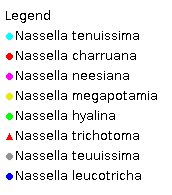Nassella* C.Gay, Fl. Chile 6: 263 (1854).
Derivation:. From Latin nassa (wicker basket with a narrow neck) and ella (diminutive), alluding to the resemblance of the spikelet to such a basket in lateral view.
Taxonomic revisions, nomenclatural references:. J.W.Vickery and S.W.L.Jacobs, Telopea 2: 17–23 (1986); M.E.Barkworth, Taxon 39: 597–614 (1990).
Key references (keys and floras):. B.K.Simon, Key to Australian Grasses 133 (1993); S.W.L.Jacobs and J.Everett, Flora of New South Wales 4: 638–639 (1993); N.G.Walsh, Flora Victoria 2: 376–378 (1994) as Stipa; D.I.Morris, Student's Flora of Tasmania 4B: 193–194 (1994); E.Edgar and H.E.Connor, Flora of New Zealand 5: 79–83 (2000); D.Sharp and B.K.Simon, AusGrass (2002); J.P.Jessop, Grasses of South Australia 107–110 (2006): S.W.L.Jacobs, R.D.B.Whalley & D.J.B.Wheeler, Grasses of New South Wales, 4th ed, 304–305 (2008); A.Wilson (ed.), Flora of Australia 44A: Poaceae 2: 64–67 (2009).
W.D.Clayton & S.A.Renvoize, Genera Graminum (1986), genus (95).
Naturalised. About 80 species, from North and (mainly) South America. 7 species in Australia, SA, NSW, Vic, and Tas. Also New Zealand.
Habit. Perennial, tufted. Leaf blades narrow. Ligule an unfringed membrane.
Inflorescence. Inflorescence paniculate.
Spikelets. Spikelets laterally compressed or subterete, pedicelled; with rachilla terminating in a floret; sessile spikelet without lower incomplete floret. Fertile spikelets laterally compressed or subterete, disarticulating above glumes.
Glumes. Glumes unequal to more or less equal, exceeding florets, long relative to adjacent lemmas (exceeding them), hairless, pointed, awned or awnless (long-acuminate), non-keeled (rounded on the back), similar (tapering from near the base, often anthocyanic). Lower glume 3 nerved (?). Upper glume 3 nerved (?).
Florets. Fertile florets 1. Lemmas tightly convolute (the margins much overlapped, concealing the palea), saccate (above, the gibbous floret characteristic of Nassella sensu stricto) or not saccate (the floret being symmetrical in most species of Nassella sensu lato), decidedly firmer than glumes, becoming indurated, entire at apex to incised (depending on degree of fusion of the lobes, and interpretation of the ‘crown’), awned, without a germination flap, obscurely 3 nerved, with nerves confluent towards tip, having flat margins not tucked into palea (but very convolute), not keeled. Awns 1, from a sinus or apical (depending on interpretation of the crown), geniculate, hairless (scabrid) or hairy, about as long as body of lemma (?) or much longer than body of lemma (mostly, commonly 11 cm or more long), deciduous (in gibbous-floreted Nassella sensu stricto) or persistent. Palea conspicuous and relatively short to very reduced (consistently less than a third of the lemma length), entire, thinner than lemma (scarious), consistently nerveless, not keeled, glabrous. Callus short to long (0.5–4 mm long), pointed or blunt. Lodicules 2. Stamens 1–3. Stigmas 2. Grain small to medium sized (?), ovate or oblong to pyriform, compressed laterally or terete. Hilum long-linear. Embryo large to small.
Kranz Anatomy. C3.
2n = 38 (N. trichotoma), commonly adventive.
Habitat. Mesophytic to xerophytic. Species of open habitats.
Classification. Pooideae; Stipeae.
Notes. A segregate from Stipa with asymmetric laterally compressed florets (Clayton and Renvoize, 1986). Its circumscription includes all species of Stipeae with strongly overlapping margins, lemma apices that are fused into a crown, paleas that are highly reduced, and glabrous, with long epiblasts, and lemma epidermes with very short fundamental cells having silicified cell walls (Barkworth 1990).
Types Species. N. pungens Desv.
Biogeographic Element. Clifford & Simon 1981, Simon & Jacobs 1990: Naturalised.



